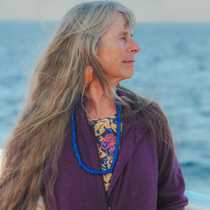San Jose Channel & Isla San Francisco
The light winds of the previous night had died completely, allowing the National Geographic Sea Bird to cruise in gentle seas as she entered the San Jose Channel just before sunrise. By 6:00am the bow was filled with quiet conversation as we waited for the sun to peak over the eastern horizon. It burst forth in shades of violet, blue and green before shedding golden light on another day in the Gulf of California and the waters between the Baja mainland and two significant islands in the southern part of the Gulf. As the sun slowly climbed into the sky, a headland of the peninsula called Cabeza Mechundo was lit in many shades of yellow, gold and red, along with deep shadows marking the many geologic layers, a reminder of the volcanic history that marks this eastern side of the Baja peninsula.
Our plans for the morning were to remain in these very productive waters in search of marine mammals. We continued our cruise along Isla San Jose and Isla San Francisco, making a very large circle while many a watchful eye remained on the bow searching the calm seas. A lone California sea lion was spotted playing in the sea, along with many mobula rays, which threw themselves completely out of the water, flipping several times before returning to the sea.
The National Geographic Sea Bird hotel staff continued their morning activities with a global market in the lounge, followed by a gathering of Yale alumni and our first presentation of the voyage by Steve Stearns, our Yale host, on Major Themes in Evolutionary Medicine. As can often happen when a presentation is ready to begin, the observant eyes on the bow find a blow in the distance. A Bryde’s whale was spotted. This particular species of marine mammal can be very difficult to watch, as its pattern of travel can be quite inconsistent; often diving and not returning to the surface in a predictable spot! Several times we were able to spot this individual from a distance, but true to form, our first marine mammal remained quite elusive.
A short time later a large group of dolphins were spotted, bringing many of us on deck, as a large group of bottlenose dolphins approached the Sea Bird to ride the pressure wave created by the ship as she moved through the water. Soon, there were six to ten dolphins riding the sweet spot just under the bow. Our first mate made several passes as the dolphins returned again and again to take a ride, watching us watching them. In the wonderfully calm conditions we could not only see these gorgeous animals, but also hear their vocalizations just under the surface of the water.
The morning passed quickly under clear blue skies. As lunch was announced, the Sea Bird was entering Half Moon Bay on Isla San Francisco. Our afternoon would be spent on this crescent-shaped sandy beach. Kayaking, hikes and swimming would all be offered. A long walk took off up and along one of the ridges of the island, while three more leisurely walks entered an arroyo, a side canyon and across the narrow center of the island for views of the slightly wind-swept beach to the east. Discoveries of birds, plants and an unusual salt flat were explored, where local fishermen still collect sea salt in the man-made evaporation pans dug into the salty soil.
Kayakers had a chance to paddle the wonderfully calm waters where several very large schools of fish were gathered, drawing not only the human observers but many brown pelicans who circled overhead, then dove rapidly, hitting the water with intense force, coming to the surface with bills full of an early dinner. Our dinner supplies were arriving from the National Geographic Sea Bird, to shore, where the head chef and hotel manager were preparing a lovely barbecue dinner! Yellow-tail tuna and fresh pizzas were being prepared by our head chef, Singyn Hunter, while our hotel manager, Kathy Whitt, set a long table filled with wonderful dishes to accompany the main courses.
A beach fire soon became our main source of light, where we were regaled with a myth from one of the oldest recorded Mexican codices…the half moon being another source of light overhead; we remained to watch as the stars filled the sky in this unusual place in the world where the desert meets the sea.




